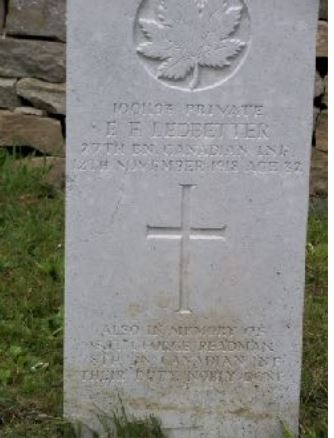27th Battalion, Canadian Infantry (Manitoba)

On 26 October 1887 Lavinia Elizabeth Ledbetter, then aged 17, gave birth to a son, whom she named Ernest Frederick. Lavinia was unmarried and his father is unknown.
In 1889 Lavinia married John Readman, a stone mason, fifteen years her senior and in time Ernest Frederick Ledbetter was joined by numerous step brothers and sisters.
On 30 April 1908, at the age of 20, Ernest emigrated to Canada, sailing from Liverpool to Quebec and eventually ending up in Birtle, Manitoba. It is believed that he found work as an agricultural labourer.
Ernest came to England, probably in early 1913 and he returned to Canada on 26 March 1913, accompanied by his step brother, George Readman, who had been born on 5 April 1893 and a friend, Harold Payne. They sailed from Liverpool to Halifax, Nova Scotia and made their way to Manitoba.
Ernest enlisted into the Canadian Army at Birtle, Manitoba on 1 April 1916 (stated age 29 years and five months) and was initially posted to 226th Overseas Battalion. He stated his occupation to be a farmer and his next of kin his mother, Lavinia Readman, of Station Road, Blockley: he was unmarried, with no previous military experience.
He sailed from Halifax, Nova Scotia on 15 December 1916, on board the troopship RMS Olympic (a sister ship of the ill-fated Titanic) and arrived at Liverpool on 28 December 1916. He transferred with his unit to Bramshott Camp, on the Hampshire and Surrey border and on 1 February 1917 he was appointed an acting Lance Corporal. On 26 March 1917 he was posted to 14 (Reserve) Battalion. On 31 May 1917 he reverted to the rank of Private, at his own request, prior to posting to France. He arrived in France on 1 June 1917 and joined the 27th (Manitoba) Battalion, sometimes known as ‘City of Winnipeg’, in the field on 7 June 1917. It was part of 6th Infantry Brigade, 2nd Canadian Division. Having spent the first two weeks of February 1918 on leave, he was awarded a Good Conduct Badge on 1 April 1918.
On 27 August 1918 he suffered a gunshot wound to his left ankle, causing a fracture at the lower end of the fibula and tibia. This was probably in the Arras area, during the Battle of the Scarpe (26 to 30 August 1918) one of the actions in the later summer early autumn attempts to break the Hindenburg Line. After an initial operation at No 7 Casualty Clearing Station, he was sent to 55 General Hospital, Boulogne and on 31 August 1918 sent to England, on board the HS Cambria.
He was admitted to Alder Hey Military Hospital, West Derby, Liverpool (which specialised in the treatment of orthopaedic cases) on 1 September 1918 and on 21st of that month underwent an operation to remove pieces of bone still present in the wounded area. Evidently his wound had practically healed when he died, suddenly, on 12 November 1918; he was 32 years old. The cause of death was discovered to be angina pectoris, a heart condition.
Following his death his remains were taken to his birthplace in Blockley, where he was buried in the Churchyard of the parish church, where a CWGC headstone now marks his grave.
His headstone also commemorates 148484 Sergeant George Readman, also of the Canadian Army. This is, of course, Ernest’s step-brother, who had travelled to Canada with him in 1913. George had worked on a farm at Hayfield, Manitoba and enlisted into the Canadian Army at Winnipeg, Manitoba on 22 November 1915. He was posted to the 78th (Manitoba) Battalion, which was part of 12th Infantry Brigade, 4th Canadian Division. He died from a shrapnel wound to the back on 8 August 1918 and is buried at Caix British Cemetery, in the Somme region of France.
Researched by Graham Adams 14 September 2016 (revised)
